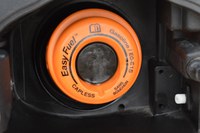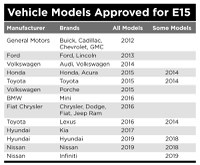Renewable Accounts: E15 fuel could help you, the environment and N.D. farmers
(Click an image below to view a high-resolution image that can be downloaded)
By David Ripplinger, Bioproducts and Bioenergy Economist and Assistant Professor
NDSU Department of Agribusiness and Applied Economics
On May 31, the U.S. Environmental Protection Agency (EPA) announced a policy change that allows E15 fuel to be sold year-round across the country. This change provides a great opportunity to learn more about the fuel.
E15, sometimes marketed as Unleaded 88, is a gasoline blend containing 15 percent ethanol. It has slightly higher octane and slightly less energy than regular gasoline.
There are a few reasons why consumers may purchase E15: it may cost less than regular gasoline, even on a mileage equivalent basis; it has a smaller carbon footprint; and it expands the market for U.S. corn.
It is important to note that it’s not how much energy there is in a fuel, but how well that fuel is converted to mechanical energy by the engine that matters. A fuel with higher energy density or octane doesn’t guarantee that a vehicle will get better mileage.
With about 2% less energy per gallon than regular gasoline, quick math can provide guidance for the purely financially-motivated consumer regarding E15 use.
If regular gasoline is $2.50 per gallon, to get the equivalent energy for the same price or less, the consumer needs to save five cents per gallon ($2.50 x .02) or more on E15. Again, actual mileage changes will vary.
Because ethanol has a smaller greenhouse gas footprint than straight gas, higher ethanol blends have smaller footprints than those with less or no ethanol. E15’s footprint is about 1% smaller than E10’s footprint.
Summertime E15 sales had been prohibited because it exceeded volatility standards designed to reduce smog. A special carve out for E10, which has approximately the same volatility as E15, was made in 1990. With the EPA’s new rule, environmentally conscious consumers can now buy fuel with a smaller greenhouse gas footprint and equivalent volatility.
In what may be a surprise to many consumers, E15 has been approved by the EPA for all car and truck engines beginning with the 2001 model year. Nearly all recent model year vehicles sold in the U.S. are approved by their manufacturers to use E15.
A sure way to see if your vehicle is warrantied to use E15 is to grab your owner manual or check your gas cap, as they usually have fueling information on them.
Now is a good time for consumers to take a few minutes and revisit the fuel their cars or trucks are approved to use and do some quick math to see if E15 works best. Five minutes could help consumers’ pocketbooks, the environment and North Dakota farmers.
NDSU Agriculture Communication – May 6, 2019
| Source: | David Ripplinger, 701-231-5265, david.ripplinger@ndsu.edu |
|---|---|
| Editor: | Kelli Anderson, 701-231-6136, kelli.c.anderson@ndsu.edu |



